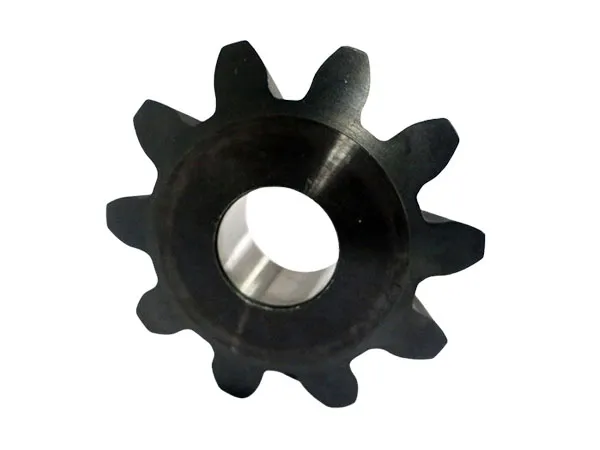- +86 13837949030 +86 15890619536
- info@lymcbearings.com export@lymcbearings.com
- Luoxin Industrial Cluster, Luoyang City,Henan Province,China

Sprockets are mechanical components used in conjunction with chains to transmit power and motion between shafts or to drive machinery. They are integral parts of chain drive systems, which are common in various applications including bicycles, motorcycles, industrial machinery, and conveyor systems. Sprockets have teeth that mesh with the chain links. The tooth profile is designed to fit the specific chain type, ensuring a secure and efficient power transfer. Common materials for sprockets include steel, aluminum, and plastic. The choice of material depends on the application’s load requirements, environmental conditions, and cost considerations. Sprockets are versatile components that play a vital role in many mechanical systems by enabling effective power transmission through chain drives. Proper selection, installation, and maintenance are key to ensuring optimal performance and longevity.
A sprocket is a toothed wheel that meshes with a chain, track, or other perforated or indented material to transmit rotary motion. Unlike gears, which mesh directly with other gears, sprockets are designed to work with a chain or belt, making them an essential component in chain-driven systems. Sprockets are widely used in a variety of mechanical systems, including bicycles, motorcycles, conveyors, industrial machinery, and tracked vehicles.
Teeth Design: Sprockets have teeth that are specifically shaped to engage with the links of a chain or track, ensuring smooth power transmission.
Material: Typically made from metals like steel, stainless steel, or cast iron, although plastics and other materials are used in specific applications where weight and corrosion resistance are factors.
Variety of Sizes: Sprockets come in various sizes and configurations to match different chain sizes and application requirements. The size of a sprocket is typically defined by its pitch (the distance between the centers of two adjacent chain roller pins) and the number of teeth.
Hub Design: Sprockets can have different hub designs, such as "A" style (no hub), "B" style (hub on one side), and "C" style (hub on both sides), depending on mounting requirements.
Drive Sprocket (Driving Sprocket):
Function: Connected to the power source, such as a motor or engine, and transmits torque to the chain.
Application: Found in bicycles (front sprocket attached to pedals), motorcycles, and machinery.
Driven Sprocket:
Function: Receives power from the chain driven by the drive sprocket and transfers it to the output shaft or other components.
Application: Located at the rear wheel of a bicycle or motorcycle or at the driven end of machinery.
Idler Sprocket:
Function: Used to maintain proper chain tension and alignment in a drive system. They do not transmit power but help guide the chain.
Application: Commonly used in conveyor systems, tensioners, and chain drives with long spans.
Roller Chain Sprocket:
Function: Specifically designed to engage with roller chains, commonly found in power transmission applications.
Application: Used in various machinery, conveyors, and automotive applications.Single, Double, and Triple Strand Sprockets:
Function: Designed to work with single, double, or triple-strand roller chains for different power transmission needs.
Application: Used in heavy-duty equipment and machinery where high torque transmission is required.
Bicycles and Motorcycles: Sprockets are used in the chain drive systems to transmit power from the pedals or engine to the wheels.
Conveyor Systems: Used to drive chains that move materials or products along a conveyor belt in manufacturing and material handling.
Automotive Timing Systems: Sprockets are used in engines to control the timing of the crankshaft and camshaft via a timing chain.
Agricultural and Construction Machinery: Used in equipment like combines, tractors, and excavators to transmit power to various components.
Tracked Vehicles: Found in vehicles such as tanks and bulldozers to drive the tracks and provide locomotion.
High Efficiency: Sprockets and chain drives are highly efficient, typically achieving efficiencies of up to 98%.
Durable and Reliable: Made from robust materials that can withstand heavy loads and harsh operating environments.
Flexibility: Sprockets can be easily adjusted or replaced to modify the speed, torque, or direction of power transmission.
Simple Maintenance: Chains and sprockets are relatively easy to maintain, requiring regular lubrication and occasional tension adjustment.
Cost-Effective: Sprockets and chains are generally less expensive than other types of power transmission systems, such as gear drives or belt drives.
Pitch and Number of Teeth: The pitch must match the chain’s pitch, and the number of teeth affects speed and torque transmission.
Material and Hardness: Sprockets must be made of materials that can withstand wear, corrosion, and environmental conditions.
Alignment and Tension: Proper alignment of the sprocket and chain, as well as maintaining the right tension, is crucial for minimizing wear and ensuring smooth operation.
Lubrication: Regular lubrication is needed to reduce friction and wear between the chain and sprocket teeth.